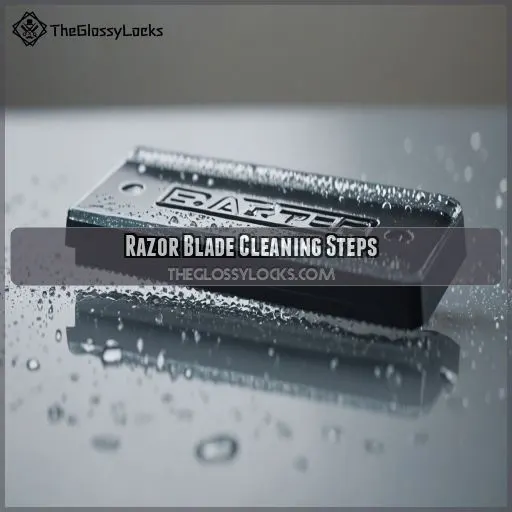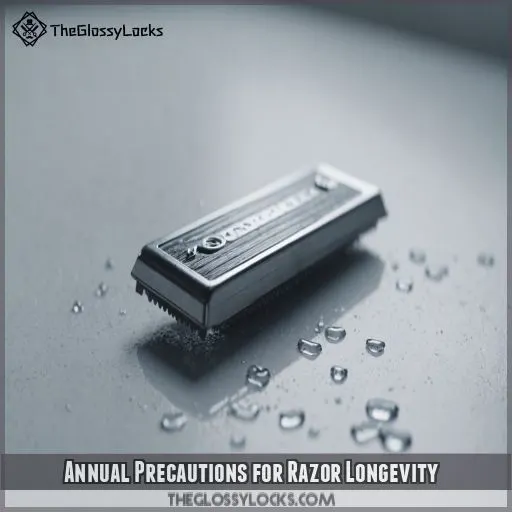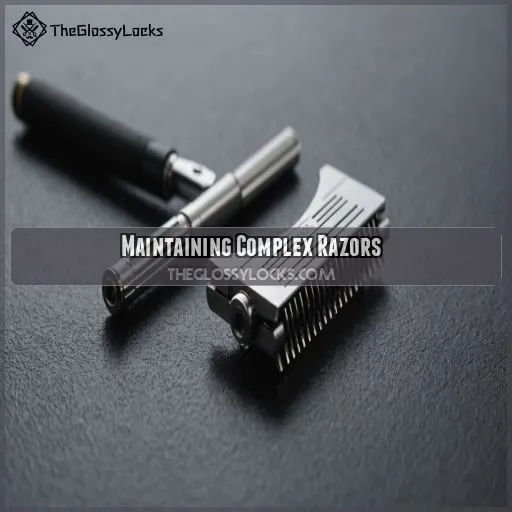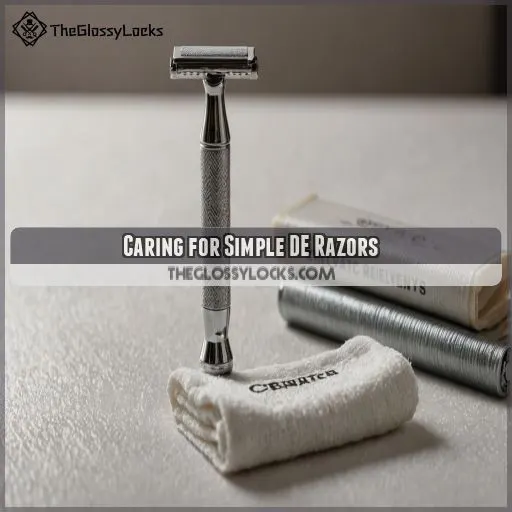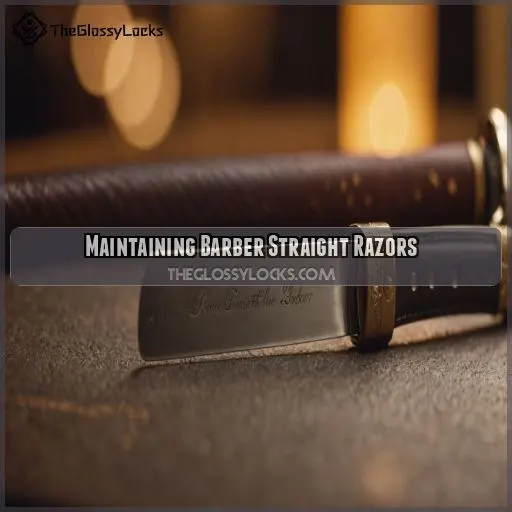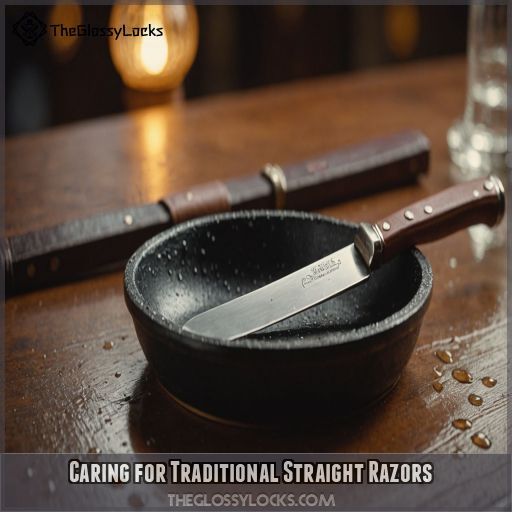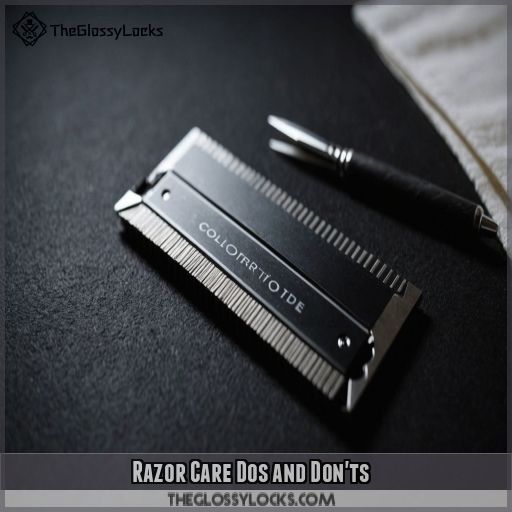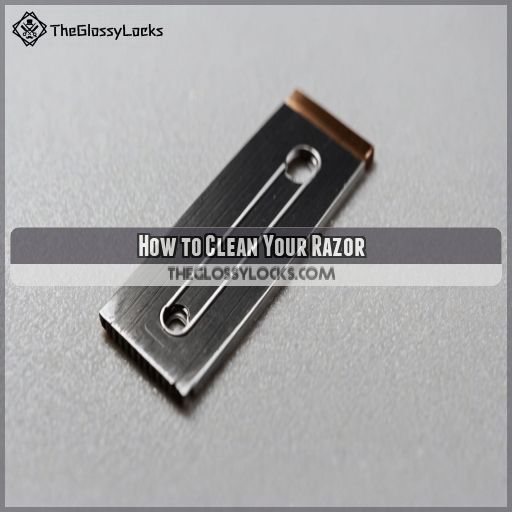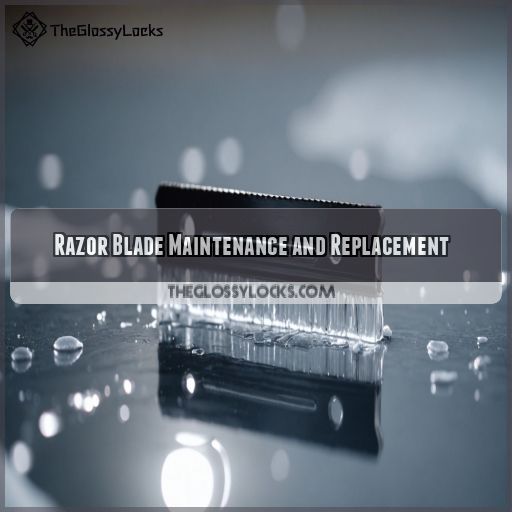This site is supported by our readers. We may earn a commission, at no cost to you, if you purchase through links.
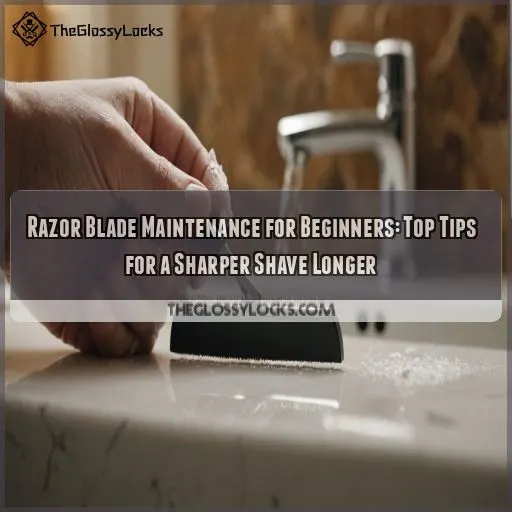 You’re finally tackling the art of razor blade maintenance! Congrats on taking the first step for a sharper shave and a healthier wallet.
You’re finally tackling the art of razor blade maintenance! Congrats on taking the first step for a sharper shave and a healthier wallet.
As a beginner, establishing a solid cleaning routine is vital. Start by rinsing your razor under hot water, then gently sweep away hair clippings and shaving cream residue with a soft-bristled brush.
Dry it thoroughly and disinfect with isopropyl alcohol. By following these simple steps, By following these simple steps, including Proper Cleaning Techniques, you’ll extend the life of your razor blades and enjoy a smoother shave.
.
But, But, there’s more to it than just cleaning – like hairbrush regular maintenance – stay tuned for expert tips on storage, handling, and replacement, helping you move in the direction of becoming a pro.
, handling, and replacement, helping you move in the direction of becoming a pro!
Table Of Contents
- Key Takeaways
- Razor Blade Cleaning Steps
- Annual Precautions for Razor Longevity
- Maintaining Complex Razors
- Caring for Simple DE Razors
- Maintaining Barber Straight Razors
- Caring for Traditional Straight Razors
- Razor Care Dos and Don’ts
- How to Clean Your Razor
- Razor Blade Maintenance and Replacement
- Frequently Asked Questions (FAQs)
- How to maintain razor blades?
- How many times should you use a razor blade before changing it?
- Do I need to oil my straight razor?
- How to properly maintain a straight razor?
- How often should I strop my straight razor blade?
- What type of oil is best for storing straight razors?
- Can I use a hair dryer to dry my razor blade?
- How do I prevent rust from forming on my razor?
- What is the best way to store my razor when traveling?
- Conclusion
Key Takeaways
- You’re just a few swipes away from a silky-smooth shave – You’re just a few swipes away from a silky-smooth shave and it all starts with proper razor blade cleaning
! By rinsing your razor under hot water, By rinsing your razor under hot water, gently sweeping away hair clippings and shaving cream residue with a soft-bristled brush, drying it thoroughly, and disinfecting with isopropyl alcohol, you’ll extend the life of your razor blades and enjoy a smoother shave.
, drying it thoroughly, and disinfecting with isopropyl alcohol, you’ll extend the life of your razor blades and enjoy a smoother shave.
- Don’t let water damage and corrosion get the best of your razor! Take some annual precautions to prevent rust, particularly if your razor is made with Zamak, a zinc alloy that can degrade over time. Protect your razor with polymeric car wax to repel water and moisture, reducing the risk of rust.
- When it comes to storing your razor, don’t just toss it aside! Proper storage is key to maintaining your blade’s sharpness and hygiene. Hang it up on a wall-mounted hanger for ideal ventilation, use a protective cover to shield it from bathroom humidity, or store it in a travel case when you’re on the go.
- Changing blades when they become dull is a no-brainer, but how do you know when it’s time? Look out for telltale signs like irritation or Soothing Razor Burn after shaving, needing multiple passes for a clean shave, visible nicks or cuts on your skin, rust spots on the blade, or that smooth, effortless shave becoming a distant memory.
, needing multiple passes for a clean shave, visible nicks or cuts on your skin, rust spots on the blade, or that smooth, effortless shave becoming a distant memory. Trust us, your skin will thank you for swapping out those dull blades!
Razor Blade Cleaning Steps
You’re about to learn the secret to a sharper shave that lasts longer – You’re just a few swipes away from a silky-smooth shave and it all starts with proper razor blade cleaning
. By following these simple steps, you’ll be able to keep your razor in top condition, prevent ingrown hairs and razor burn, and make the most out of your shaving experience.
Rinsing and Flushing the Razor
Your razor’s best friend? A good rinse! To keep your blade in top shape, rinse it under hot water with decent water pressure to flush out debris. Here’s how:
- Hold the razor head under the stream to loosen gunk.
- Rotate the razor for all-angle cleaning.
- Gently tap to dislodge stubborn bits.
- Repeat until the water runs clear.
Brushing Away Buildup
Your trusty razor’s got some unwanted guests – hair clippings and shaving cream residue. Time to bring in the cleaning cavalry! Grab a dedicated razor brush or a soft-bristled toothbrush to gently sweep away the debris.
| Razor Brush Types | Cleaning Frequency |
|---|---|
| Soft-bristled toothbrush | After every 3-4 uses |
| Dedicated razor brush | Daily, for heavy users |
| Nylon-bristled brush | Weekly, for maintenance |
Drying the Razor Thoroughly
After rinsing your razor, it’s time to dry it thoroughly.
Air-drying is the best way to dry your razor.
If you’re in a hurry, If you’re in a hurry, gently dab it with a microfiber towel trick.
.
Avoid rubbing or using hot water, as this can lead to rust.
You can even use a hair dryer on low heat for a quick dry.
Proper drying prevents rust and keeps your razor in top shape.
Disinfecting With Alcohol
You’ve dried your razor, now it’s time to disinfect it with alcohol. This step is a game-changer for shaving hygiene. To do it safely:
- Use isopropyl alcohol that’s at least 70% pure
- Swish the razor back and forth vigorously for a few seconds
- Soak the razor for a longer period for a more thorough cleaning
Annual Precautions for Razor Longevity
You’re probably thinking that cleaning your razor is a no-brainer, but there’s actually more to it than just rinsing it under the faucet – especially if you want it to last.
You’ll want to take some annual precautions to prevent water damage and corrosion, particularly if it’s made with Zamak, a zinc alloy that can degrade over time.
Understanding Zamak and Its Limitations
Now that you’ve mastered the art of cleaning your razor, let’s talk about the materials that make it tick – specifically, Zamak. This zinc alloy is commonly used in razor parts, but it has its limitations. Zamak’s durability and corrosion resistance are compromised when exposed to water, which can lead to a shorter lifespan and duller blades.
Protecting the Razor With Polymeric Car Wax
You’ve learned about Zamak’s limitations, now it’s time to shield your razor from the elements. Applying a layer of polymeric car wax annually creates a protective barrier against water and air, preserving the razor’s finish. Here are some key benefits:
- Repels water and moisture, reducing rust risk
- Protects the blade edge from corrosion
- Easy to apply, with no harsh chemicals
Preventing Nickel Plating Oxidation
You’ve protected your razor with polymeric car wax – now it’s time to prevent nickel plating oxidation.
To extend the lifespan of your nickel-plated razor, dry it thoroughly after each use and store it in a low-humidity environment.
Use a plating care product to maintain the shine and prevent rust.
This will keep your razor blades looking and performing like new.
Maintaining Complex Razors
You’re probably aware that not all razors are created equal, and the more complex ones require a bit extra TLC to keep them performing at their best.
If you’re the proud owner of an adjustable DE razor, don’t worry – with a few simple steps, you can minimize water exposure, disassemble and dry its components, and keep it in top shape.
Caring for Adjustable DE Razors
Caring for your adjustable DE razor requires some extra TLC. To keep it in top shape, disassemble it after each use and give it a good rinse to remove any soap and stubble. Then, dry each part thoroughly with a towel and some air blowing to prevent water spots. Store the disassembled parts to promote evaporation of any residual moisture.
Minimizing Water Exposure
- Dry thoroughly: After rinsing, shake off excess water and use a microfiber towel to dry.
- Waterproof storage: Store your razor in a waterproof case or bag.
- Humidity control: Keep your bathroom well-ventilated to reduce humidity.
- Razor drying station: Consider a drying station with moisture-absorbing materials to keep your razor dry.
Disassembling and Drying Components
Now that you’re minimizing water exposure, it’s time to disassemble and dry those components! For complex razors, this step is a game-changer. Here’s a quick rundown:
| Component | Drying Technique |
|---|---|
| Stainless steel parts | Dry with a soft cloth, then apply a thin layer of mineral oil |
| Delicate mechanisms | Use a soft-bristled brush to gently sweep away moisture |
| Handles and grips | Wipe down with rubbing alcohol and let air dry |
Caring for Simple DE Razors
You’re likely no stranger to the humble DE razor, a simple yet effective tool that still requires some TLC to keep it in top shape. By following a few easy steps, you can keep your simple DE razor in great condition, ensuring a sharper shave and a longer lifespan for your trusty blade.
Disassembling and Drying the Razor
In the case of your simple DE razor, a little TLC goes a long way. Disassembling and drying the razor after each use is key to preventing water spots and bacterial growth. Here’s how to do it:
- Remove the blade and rinse with warm water
- Dry the handle and blade separately with a towel
- Use a soft cloth to wipe down the razor head
- Store the disassembled razor in a well-ventilated area
Removing Soap and Stubble
Time to tackle the not-so-glamorous task of removing soap and stubble from your trusty DE razor. Don’t worry, it’s a breeze.
| Cleaning Task | Tips and Tricks |
|---|---|
| Shaving Cream Removal |
Use a soft cloth or brush to wipe away shaving cream residue.
Soak the razor in warm water to loosen soap scum, then scrub with a soft-bristled brush.
Clean your stubble brush regularly to prevent clogged bristles.
Gently wipe the razor with a dry cloth after cleaning to prevent water spots.
Storing the Disassembled Components
Now that you’ve removed soap and stubble from your simple DE razor, it’s time to store the disassembled components. You’ll want to keep them dry and organized to prevent damage. Consider a small container or pouch with separate compartments for each part. This will keep your razor parts tidy and protected, ensuring a smoother shave next time around.
Maintaining Barber Straight Razors
Maintaining your barber straight razor is a breeze – simply wipe off any lather and stubble after use, and store it in a low-humidity environment to keep it in top shape. By following these easy steps, you’ll be able to keep your razor clean, dry, and ready for its next use, ensuring a smoother shave every time.
Wiping Lather and Stubble
In terms of wiping lather and stubble from your barber straight razor, you’ll want to get a little gentle. Use a towel or toilet tissue to carefully wipe away any remaining shaving cream and stubble, avoiding water contact with the razor. This simple step helps prevent rust and keeps your blade in top condition.
Storing in a Low-Humidity Environment
To keep your barber straight razor in top shape, store it in a low-humidity environment. This will help prevent rust and corrosion. Consider using a storage case with a silica gel packet or a dehumidifier to maintain a dry atmosphere. Even a simple airtight container in a dry closet can do the trick. Your razor will thank you!
Caring for Traditional Straight Razors
As you master the art of shaving with a traditional straight razor, you’ll want to keep it in top condition to guarantee a smooth, nick-free experience. To do this, you’ll need to adopt a few simple habits, such as avoiding unnecessary water exposure, stropping the razor after each shave, and coating it with oil or petroleum jelly for storage.
Avoiding Unnecessary Water Exposure
With traditional straight razors, you want to be water-wise. Since they’re made from high-carbon steel or stainless steel, unnecessary water exposure can lead to rust. So, wipe lather and stubble off the blade during the shave, and keep your hands dry to prevent the razor from slipping. Your razor will thank you!
Stropping the Razor After Each Shave
After patting your razor dry, it’s time to give it a good stropping.
This isn’t just for show, it’s a key step in razor blade maintenance.
Grab your leather strop and get ready to work some magic.
With smooth, consistent strokes, you’ll realign the blade’s edge, keeping it sharp and ready for your next shave.
It’s like giving your razor a mini spa day!
Coating With Oil or Petroleum Jelly for Storage
For long-term storage, treat your straight razor like a prized possession.
Coat all metal surfaces with a thin layer of oil or petroleum jelly.
This is like giving your blade a cozy blanket against rust.
Just be careful to avoid those plastic scales!
This simple step can be a game-changer for razor longevity.
Whether you’re a jelly fan or an oil aficionado, this razor maintenance trick will keep your blade sharp and ready for its next shave.
Razor Care Dos and Don’ts
You’ve got your razor, but do you know how to treat it right? Let’s walk through the dos and don’ts of razor care to keep your blade sharp and your shaves smooth for longer.
Avoiding Damage to Precision-Engineered Parts
Every razor is a marvel of engineering, so treat yours with care.
Don’t tap it against the sink—that’s a surefire way to damage those precision parts.
Instead, handle your razor like a pro: store it in a travel case or on a hanger when not in use.
Your face (and wallet) will thank you!
Properly Rinsing and Drying the Razor
Now that you’ve dodged the precision-part pitfalls, let’s tackle rinsing and drying like a pro.
Don’t just splash and dash!
Give your razor a thorough rinse under warm water after each stroke.
Shake off excess water, but resist the urge to wipe it on a towel – that’s a blade-dulling no-no.
Instead, let it air dry in a well-ventilated spot.
Your razor will thank you with a smoother shave!
Storing the Razor Safely
After your shave, don’t just toss your razor aside! Proper storage is key to maintaining your blade’s sharpness and hygiene. Here are some razor-safe storage tips:
- Hang it up on a wall-mounted hanger for ideal ventilation
- Use a protective cover to shield it from bathroom humidity
- Store it in a travel case when you’re on the go
- Keep it in a dry, well-ventilated area to prevent rust
- Consider a humidity-controlled storage solution for shaving enthusiasts
How to Clean Your Razor
You might think cleaning your razor is as simple as running it under the tap, but there’s a bit more to it if you want to keep your blades in tip-top shape. Let’s explore some easy yet effective methods to clean your razor and extend its life, saving you both irritation and cash in the long run.
Rinsing the Razor Blades
Now that you know what not to do, let’s focus on giving your razor a proper rinse. You’ll want to use water pressure to your advantage here. Hold your razor under the faucet, angling it to flush out any stubborn debris. Here’s a quick guide to rinsing like a pro:
| Step | Action |
|---|---|
| 1 | Turn on warm water |
| 2 | Angle razor backwards |
| 3 | Let water flow through blades |
| 4 | Rotate razor for full coverage |
| 5 | Tap gently to dislodge debris |
Swishing Through Standing Water
After rinsing your razor, let’s explore a water-wise technique that’ll make you feel like a pro barber. Swishing your blade through standing water isn’t just environmentally friendly—it’s a time-saving game-changer. Fill your sink with about an inch of warm water and get ready to master this cleaning efficiency trick. Here’s why it’s a cut above:
- Conserves water like a desert cactus
- Mimics high-end barbershop techniques
- Traps debris, leaving your blade squeaky clean
- Works for all razor types, from high-carbon steel to disposables
Removing the Blades for Cleaning
Now, let’s get up close and personal with your razor. Removing the blades for cleaning isn’t just for neat freaks – it’s a game-changer for your shave. Here’s a quick guide to blade removal technique and cleaning frequency:
| Razor Type | Removal Method | Cleaning Frequency |
|---|---|---|
| Cartridge | Press release button | After 3-5 shaves |
| Safety | Unscrew top cap | Weekly |
| Straight | No removal needed | After each use |
| Electric | Pop-off foil cover | Monthly |
Razor Blade Maintenance and Replacement
You’ve mastered the art of cleaning your razor, but proper maintenance doesn’t stop there. Let’s explore how to keep your blades in top shape and when it’s time to swap them out, ensuring you always get the smoothest shave possible.
Changing Blades When They Become Dull
Now that you’ve mastered cleaning, let’s talk about when to retire those blades. Ever noticed your razor tugging instead of gliding? That’s your cue to switch things up. Here are some telltale signs it’s time for a fresh blade:
- Irritation or razor burn after shaving
- Needing multiple passes for a clean shave
- Visible nicks or cuts on your skin
- Rust spots on the blade
- That smooth, effortless shave is a distant memory
Don’t push your luck with dull blades – your skin will thank you!
Considering a Razor Subscription Service
Once you’ve got the hang of changing blades, you might want to explore a razor subscription service. It’s like having a personal shopper for your shaving needs! Let’s break down the pros and cons:
| Aspect | Pros | Cons |
|---|---|---|
| Convenience | Regular deliveries | Potential overstock |
| Cost | Bulk discounts | Locked-in prices |
| Variety | Try new products | Limited brand options |
| Customization | Personalized to your needs | May not suit everyone |
These services can be a game-changer for your shaving routine and budget.
Practicing Good Razor Maintenance Habits
Every shaver worth their salt knows that good razor maintenance habits are the secret to blade longevity.
Make cleaning your razor a ritual, not a chore. After each shave, give it a thorough rinse and let it air dry.
When you’re on the go, pack a travel case to keep your blade safe.
Frequently Asked Questions (FAQs)
How to maintain razor blades?
You’ll want to rinse your razor blades after every few strokes, shake off excess water, and dry them thoroughly to prevent rust and bacteria growth – and don’t forget to change them when they get dull!
How many times should you use a razor blade before changing it?
You should change your razor blade when you feel it becoming dull – it’s that simple! Wear and tear varies for each person, so shop for new blades when your current ones stop being effective.
Do I need to oil my straight razor?
How to properly maintain a straight razor?
Did you know a well-maintained straight razor can last up to 20 years? To keep yours in top shape, regularly strop the blade to clean and dry it, and store it in a dry place with a thin layer of oil.
How often should I strop my straight razor blade?
To keep your straight razor blade sharp, strop it 20-25 times on linen and 25 times on leather before and after each shave, and whenever you notice a decrease in its performance .
What type of oil is best for storing straight razors?
Did you know that 70% of straight razor damage is caused by improper storage? For storing straight razors, you’ll want to use a light, non-corrosive oil like camellia or mineral oil to keep the blade rust-free and in top condition.
Can I use a hair dryer to dry my razor blade?
You can use a hair dryer on a low heat setting to dry your razor blade, but be cautious not to apply too much heat, which can damage the blade or handle .
How do I prevent rust from forming on my razor?
To prevent rust from forming on your razor, rinse it thoroughly, dry it with a microfiber towel, and store it in a well-ventilated area . Regularly applying a thin layer of oil or petroleum jelly also helps .
What is the best way to store my razor when traveling?
Just like a knight securing their trusty sword, you’ll want to protect your razor on-the-go! Store it in a travel case or cover to shield the blade and prevent accidental nicks – your skin (and fellow travelers) will thank you!
Conclusion
So, are you ready to give your razor the TLC it deserves?
By following these simple yet effective tips, you’ll be well on your way to mastering razor blade maintenance for beginners.
Stay on top of cleaning, storage, and replacement, and you’ll be enjoying silky-smooth shaves in no time.
Happy shaving, and don’t forget to show your razor some love!

